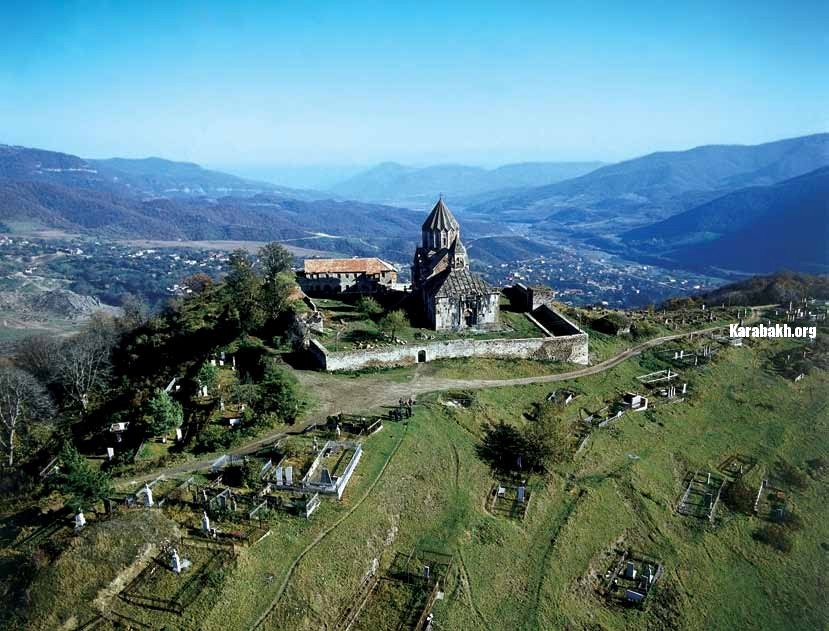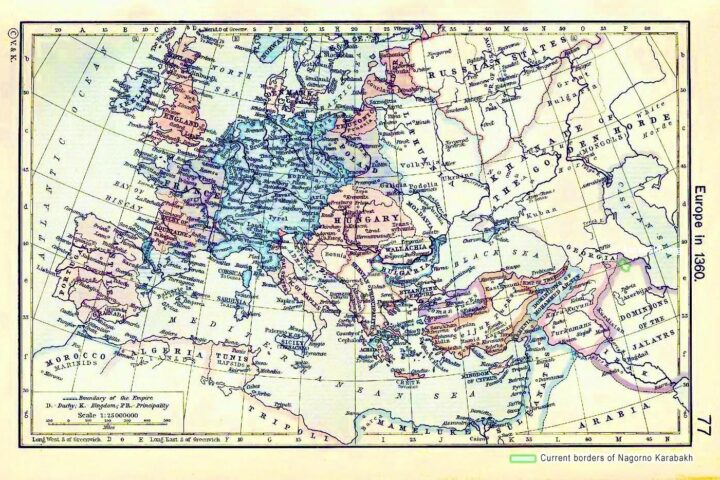In the latter half of the 11th century, the Seljuks established control over Azerbaijan and made Shaddadids their allies. Karabakh was also conquered by the Seljuks. [ref]Al-Husseini, ahbar ad-daulat as-Seljukita, p. 144-146[/ref] During this period in 1062 and 1065, the Alans raided Karabakh twice, plundered its lands and took many people hostage. [ref]M. Artamonov, History of the Khazars, Leningrad, 1962, p. 22[/ref]
After the weakening of the Arab caliphate, the Sunik and Artsakh-Khachen principalities were established in Karabakh. The Khachen principality achieved a high level of development under the rule of Hasan Jalal Mehranid (1215-1261), who is described by the narrative and epigraphic sources of the time as the “prince of the Khachen country”, “the great prince of the countries of Khachen and Artsakh” and “the ruler of Albania”. It was in his rule that the Ganjasar (Gandzasar) temple, one of the most prominent monuments of Christian Albanian architecture, was built.
According to subsequent researches, Armenians suggested that a significant proportion of Albanians from Sunik and Artsakh were converted to Armenians in the 13th century. The fact that the Khachen principality which emerged in Artsakh in the late 12th century was “part of ancient Albania” was been confirmed by the first president of the Armenian Academy of Sciences, I. Orbeli (1887-1961). In the early 20th century, he studied Albanian epigraphy of Artsakh- Khachen, copied 300 inscriptions of the 12-13th centuries and published the “Inscriptions of Gandzasar” in Petrograd in 1919 [ref]I. Orbeli, Inscriptions of Gandzasar, Petrograd, 1919; ibid, Household forms on Khachen stones of the 12-13th centuries, Selected works, Yerevan, 1963[/ref].
In the first quarter of the 12th century Karabakh was part of the Azerbaijani Ildenizid state of Atabegs.[ref]Mkhitar Gosh, Albanian chronicles, p. 236-272, 250; Z. Bunyadov, the Azerbaijani State of Atabegs, Baku, 1984, p. 15[/ref] In 1136, Seljuk sultan Masud appointed Atabeg Shamsaddin Ildeniz as governor of Aran. Gradually, he established control over the whole of Azerbaijan[ref]Z. Bunyadov, the Azerbaijani State of Atabegs, Baku, 1984, p 44; Mkhitar Gosh, Albanian chronicles, Baku, 1984, p. 236.[/ref] There are known coins minted in Karabakh, which confirms its importance in the country’s life.[ref]A. Rajabli, Numismatics of Azerbaijan, Chapter 5[/ref]
13–14th centuries
Mongol incursions in Azerbaijan in the early 13th century proved disastrous, as cities were destroyed and the population exterminated.[ref]Rashid ad-Din, Jami ad-Tavarih, Vol, 3, Baku, 1957, p. 28; Kirakos Gandzaksiy, History, Baku, 1957, p. 167[/ref] After the first Mongol raid, the Kipchaks invaded from the north. Capitalizing on the situation, the Georgians too carried out plundering raids on Karabakh. [ref]Sources on the history of Azerbaijan, p. 145, 149-150; Ibn ad-Asir, Al-Kamil fi-t-Tarih, Baku, 1959, p. 21, 148; r. Huseynov, Syrian sources of the 12-13th centuries on Azerbaijan, Baku, 1960[/ref]
In 1225, Khorezmshah Jalal ad- Din invaded and seized Azerbaijan, including Karabakh. [ref]An-Nasawi, Life of Sultan Jalal ad-Din Mankburni, p. 163; V. Piriyev, Azerbaijan in the 13-14th centuries, Baku, 2003, p. 118[/ref] In 1231, the Mongols attacked Azerbaijan again, and starting from 1239 the country and the entire South Caucasus were ruled by Mongol khans. In 1259, on orders from Khulagu Khan, the Mongol army headed by Argun occupied Karabakh. [ref]Rashid ad-Din, Jami ad-Tavarih[/ref] In the aftermath of that, this and other regions of Azerbaijan were turned into a battlefield between the Golden Horde and the Khulagid state.
Despite all this, Karabakh, which became part of Khulagid possessions, experienced the development of crafts, commerce and culture. In the
14th century, especially under the rule of Sultan Abu-Said, Khulagid coins were minted here. In fact, many of Karabakh’s historical monuments belong to this period.[ref]History of Azerbaijani archirecture; E. Pakhomov, mausoleum towers in Barda and their inscriptions[/ref] In the late
15th century, great conqueror Timur entered Karabakh.[ref]Zeynaddin Qazwini, Zeyl-e Tarihe-goside, Baku, 1990, p. 27-30[/ref] His incursions inflicted serious damage to Karabakh.
In the early 15th century, the region became the venue of clashes between the Timurids and the state of Kara Koyunlu[ref]. In 1408, the Timurid rule in Azerbaijan was ended, while in 1410 Kara Yusif captured Tabriz and seized power. The Azerbaijani state of Kara Koyunlu emerged, covering Karabakh, Southern Azerbaijan and Arab Iraq.Zeynaddin Qazwini, p. 27-30[/ref]
15–17th centuries
There were three major states in Azerbaijan in the 15th century
– Shirvan, Kara Koyunlu and Ak Koyunlu. The territories of Kara Koyunlu and Ak Koyunlu covered the south of Azerbaijan and Karabakh, stretching to the Kura in the north, including Ganja and Shamkir.[ref]Y. Mahmudov, Relations of Ak Koyunlu and Safavid states with West European countries, Baku, 1991, p. 31[/ref] In the late 15th century, there were only two major Azerbaijani states, Ak Koyunlu and Shirvan.[ref]I. Petrushevskiy, Azerbaijani states in the 15th century, Baku,1949, p. 165; S. Farzaliyev, Azerbaijan in the 15-16th centuries, Baku, 1983, p. 113[/ref]
After killing Jahanshah of Kara Koyunlu, Uzun Hasan Ak Koyunlu sent his elder son Khalil to Tabriz and seized the throne in Azerbaijan.[ref]S. Farzaliyev, mentioned work, p. 103; S. Onullahi, History of Tabriz of the 13-18th centuries, Baku, 1982[/ref]
However, the death of the last Ak Koyunlu ruler Yagub led to domestic strife which eventually weakened the state. Emir Yarahmed Karaman, a descendant of Oghuz tribes who earlier possessed Karabakh, seized power in Azerbaijan in 1496.[ref]I. Petrushevskiy, Description of the history of feudal relations in Azerbaijan and Armenia, Leningrad, 1949, p. 163[/ref] In fact, coins were minted in his name in Karabakh.[ref]E. Pakhomov, Coin hoards, Edition 1, p. 28[/ref]
In 1501, the Safavid Azerbaijani state was established by Shah Ismayil I.[ref]S. Farzaliyev, mentioned work, p. 113; S. Onullahi, mentioned work[/ref] Karabakh and the rest of Azerbaijan found themselves under the rule of the Safavids. The Ziyadoglu family, descendants of the Kajars, ruled the Karabakh.
Beglarbegi, one of the four components of the Safavid state, for over two centuries. The Karabakh Beglarbegi with the center in Ganja covered the area between the Kura and Aras rivers, including Barda, Bargushat, Akhstabad, Arasabar, Javanshir, and some Georgian territories[ref]A. Rahmani, Azerbaijan in the late 16th and 17th centuries, Baku, 1981, p. 88[/ref]
When Mustafa Pasha conquered Azerbaijan (1578) under the rule of Ottoman sultan Murad III (1574-1594), Farhad Pasha marched through Georgia and entered Karabakh where he stationed Ottoman troops. As a result of the Ottoman-Safavid war, a significant proportion of the Turkic population of Karabakh left the region. In the early 17th century, an uprising broke out in Karabakh, but in 1606 Shah Abbas I suppressed it and appointed Davud Khan as Beglarbeg of Karabakh, thus putting an end to the rule of Kajars in Karabakh. However, after the death of Shah Abbas I the Kajars regained control over the Karabakh Beglarbegi.
Therefore, for the entire duration of the period described in the article Karabakh remained an integral part of Azerbaijan. The vast majority of its population was formed by Albanian and then Azerbaijani tribes.






